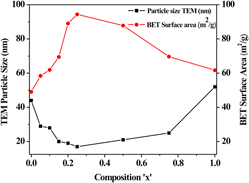Crossref Citations
This article has been cited by the following publications. This list is generated based on data provided by
Crossref.
Ahmad, Tokeer
and
Phul, Ruby
2015.
Magnetic Iron Oxide Nanoparticles as Contrast Agents: Hydrothermal Synthesis, Characterization and Properties.
Solid State Phenomena,
Vol. 232,
Issue. ,
p.
111.
Kaur, Imanpreet
and
Verma, N.K.
2015.
Magnetic and electric properties of BFO–NFO nanocomposites.
Materials Science in Semiconductor Processing,
Vol. 33,
Issue. ,
p.
32.
Khirade, Pankaj P.
Birajdar, Shankar D.
Humbe, Ashok V.
and
Jadhav, K. M.
2016.
Structural, Electrical and Dielectrical Property Investigations of Fe-Doped BaZrO3 Nanoceramics.
Journal of Electronic Materials,
Vol. 45,
Issue. 6,
p.
3227.
Ahmad, Tokeer
2017.
Hydrothermal Synthesis, Characterization and Dielectric Properties of Zirconia Nanoparticles.
Material Science & Engineering International Journal,
Vol. 1,
Issue. 3,
Ahmad, Tokeer
Ubaidullah, Mohd
Shahazad, Mohd
Kumar, Dinesh
and
Al-Hartomy, Omar A.
2017.
Reverse micellar synthesis, structural characterization and dielectric properties of Sr-doped BaZrO3 nanoparticles.
Materials Chemistry and Physics,
Vol. 185,
Issue. ,
p.
31.
Ahmad, Tokeer
Ubaidullah, Mohd
Lone, Irfan H.
Kumar, Dinesh
and
Al-Hartomy, Omar A.
2017.
Microemulsion synthesis, structural characterization and dielectric properties of Ba 1-x Pb x ZrO 3 (0.05 ≤ x ≤ 0.20) nanoparticles.
Materials Research Bulletin,
Vol. 89,
Issue. ,
p.
185.
Engels, J.
Griesche, D.
Waser, R.
and
Schneller, T.
2017.
Thin film proton conducting membranes for micro-solid oxide fuel cells by chemical solution deposition.
Thin Solid Films,
Vol. 636,
Issue. ,
p.
446.
Ahmad, Tokeer
and
Lone, Irfan H
2018.
Structural characterization and properties of
$$\hbox {YCrO}_{3}$$
YCrO
3
nanoparticles prepared by reverse micellar method.
Bulletin of Materials Science,
Vol. 41,
Issue. 1,
Ahmad, Tokeer
Farooq, Umar
and
Phul, Ruby
2018.
Fabrication and Photocatalytic Applications of Perovskite Materials with Special Emphasis on Alkali-Metal-Based Niobates and Tantalates.
Industrial & Engineering Chemistry Research,
Vol. 57,
Issue. 1,
p.
18.
Ahmad, Tokeer
Phul, Ruby
and
Khan, Huma
2019.
Iron Oxide Nanoparticles: An Efficient Nano-catalyst.
Current Organic Chemistry,
Vol. 23,
Issue. 9,
p.
994.
Kaur, Balwinder
Chand, Subhash
Singh, Karamjit
and
Malik, Ashok Kumar
2019.
Detoxification of dye contaminated water by Mn
$$^{2+}$$
2
+
-doped ZnS nanostructures.
Bulletin of Materials Science,
Vol. 42,
Issue. 2,
Ubaidullah, Mohd
Ahmed, Jahangeer
Al-Enizi, Abdullah M.
Tyagi, Akshi
Shaikh, Shoyebmohamed F.
Tarannum, Nazia
and
Ahmad, Tokeer
2020.
Metal organic precursor derived Ba1-xCaxZrO3 (0.05 ≤ x ≤ 0.20) nanoceramics for excellent capacitor applications.
Journal of King Saud University - Science,
Vol. 32,
Issue. 3,
p.
1937.
Sang, Yafei
Shao, Lishu
and
Huang, Jianhan
2020.
Carbonyl functionalized hyper-cross-linked polymers for CO2 capture.
Journal of Polymer Research,
Vol. 27,
Issue. 7,
Shimoga, Ganesh
and
Kim, Sang-Youn
2020.
High-k Polymer Nanocomposite Materials for Technological Applications.
Applied Sciences,
Vol. 10,
Issue. 12,
p.
4249.
Lone, Irfan H.
Aslam, Jeenat
Radwan, Nagi R.E.
Akhter, Arifa
Bashal, Ali H.
and
Shiekh, Rayees A.
2020.
Review on Polymeric Citrate Precursor and Sono-chemical Methods for the Synthesis of Nanomaterials.
Current Analytical Chemistry,
Vol. 16,
Issue. 7,
p.
826.
Naushad, Mu.
Ahamad, Tansir
Ubaidullah, Mohd
Ahmed, Jahangeer
Ghafar, Ayman A.
Al-Sheetan, Khalid M.
and
Arunachalam, Prabhakarn
2021.
Nitrogen-doped carbon quantum dots (N-CQDs)/Co3O4 nanocomposite for high performance supercapacitor.
Journal of King Saud University - Science,
Vol. 33,
Issue. 1,
p.
101252.
Joshi, Priyanka
Nemiwal, Meena
Al-Kahtani, Abdullah A.
Ubaidullah, Mohd
and
Kumar, Dinesh
2021.
Biogenic AgNPs for the non-cross-linking detection of aluminum in aqueous systems.
Journal of King Saud University - Science,
Vol. 33,
Issue. 6,
p.
101527.
Khirade, Pankaj P.
Raut, A.V.
Alange, R.C.
Barde, W.S.
and
Chavan, Apparao R.
2021.
Structural, electrical and dielectric investigations of cerium doped barium zirconate (BaZrO3) nano-ceramics produced via green synthesis: Probable candidate for solid oxide fuel cells and microwave applications.
Physica B: Condensed Matter,
Vol. 613,
Issue. ,
p.
412948.
Ubaidullah, Mohd
Fazil, Mohd
and
Ahmad, Tokeer
2022.
Short review on fabrication, structural and dielectric characterization of zirconium based oxide nanoparticles.
Material Science & Engineering International Journal,
Vol. 6,
Issue. 4,
p.
152.
Subramanian, Yathavan
Abdalla, Abdalla M.
Azad, Atia Tasfiah
Omeiza, Lukman Ahmed
Dhanasekaran, Anitha
Rahman, Md. Mosfiqur
Eladl, Abdelkhalik
Dawood, Mohamed M.K.
and
Azad, Abul Kalam
2024.
Advanced Ceramic Coatings for Energy Applications.
p.
117.





